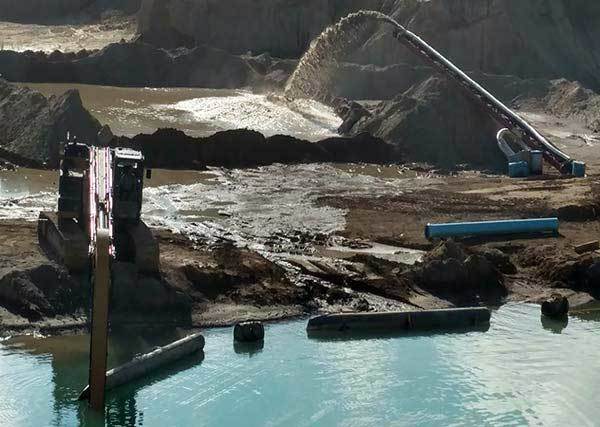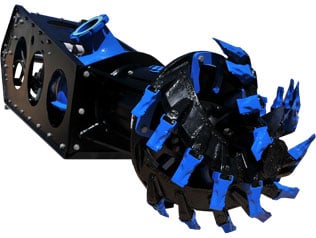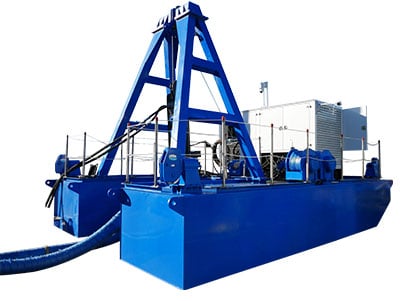Sand & Gravel Pump Applications
EDDY Pump has developed various ways to avoid costly trucks associated with sand & aggregate processing and instead pump the sand and gravel directly from the pit into the processing plant. This saves the plant millions of dollars a year.
Sand and Gravel Slurry Pump Applications:
- Construction: Gravel is often used in the construction of roads, bridges, buildings, and other infrastructure projects. Pumping gravel allows the material to be moved quickly and efficiently to the work site, reducing labor costs and increasing productivity.
- Dredging: Gravel and sand are commonly used in dredging operations to help maintain waterways and harbors. Dredging is the process of removing sediment and debris from the bottom of a body of water.
- Mining: Gravel is often used in the mining industry as a component of the materials used to construct access roads, haul roads, and processing facilities.
- Flood Control: Gravel is often used as a component of flood control systems to help protect against erosion and to slow the flow of water.
- Environmental Remediation: Gravel is used in various environmental remediation projects such as stormwater management, wetland and stream restoration, or oil spill cleanup.
- Marine Works: Gravel is frequently used in marine works such as the construction of breakwaters, jetties, and foundations of offshore structures. Pumping gravel allows the material to be placed quickly and efficiently in these applications
- Transporting Sand, Gravel, Chat, and Aggregate*
- Sumps
*Fluid Required – Seems obvious, but our pumps do NOT pump dry sand. No pumps do.
What Are The Problems With Pumping Sand and Gravel?
Sand and gravel aggregate pits are usually dredged using draglines or excavators to mechanically dig up the sand or gravel, then place it into large piles to await transport and processing. The sand and aggregate are then loaded into large dump trucks and driven to the processing plant. This is a very costly and time-consuming process that incorporates very costly equipment and manpower.
EDDY Pump has developed various ways to avoid all these headaches and instead pump the sand and aggregate directly from the pit into the processing plant. This can potentially save the plant millions of dollars a year.
Pumping sand and gravel can be a challenging task because these materials are typically abrasive and dense, which can become suspended in the fluid being pumped, which can cause blockages and clogs in the pump and pipelines. This can lead to reduced efficiency and increased downtime for maintenance and repairs.
Another problem with pumping sand and gravel is that it can be difficult to maintain a consistent flow rate. These materials can settle out of suspension and clog pipelines, which can restrict flow and cause pressure changes in the pump. This can lead to uneven and unpredictable pumping, which can make it difficult to achieve desired flow rates.
Also, Some sand and gravel pumps are not suited for the heavy-duty work that is needed for this application and these pumps may wear down prematurely or have reduced pump efficiency.

Additionally, sand and gravel can be highly corrosive, which can cause damage to the pump and other equipment over time. This can increase the frequency of repairs and maintenance, and ultimately reduce the lifespan of the equipment.
Finally, environmentally, if the process is not managed properly, it can cause negative impact on environment, such as damage to natural habitats, and also the sedimentation of nearby bodies of water.
The EDDY Pump’s unique design allows sand and gravel mines to pump the material at production rates of up to 450 cubic yards or 800 tons of material per hour. Due to the EDDY Pump design allowing it to pump higher solids content, the processing plants will be dealing with significantly less water. On average the EDDY Pump will handle about 40-70% solids by weight. The EDDY Pump’s open rotor design also allows the pump to pump rocks up to 9-inch in diameter without clogging. For operations where the plants prefer to screen down the aggregate size, classifiers can also be added at the front of the pump eliminating oversized rocks.
The best EDDY Pump dredges for the sand and gravel mining industry are the Excavator Pump Attachment, Remote-Operate Dredge, and Cable Deployed Dredge Pump.
Sumps in the sand and gravel industry play a crucial component in collecting all the sand, chat, rocks, and debris that are cast out during the processing. All these rocks, debris and abrasive material cause constant issues for centrifugal sump pumps. This means constant downtime and costly repairs. These abrasive sands quickly wear out the impellers of the pumps, in addition to the and the rocks and debris clogging the low tolerance centrifugal pumps.
The EDDY Pump is the ideal solution for these sand and gravel sumps and can be deployed electrically, hydraulically or self-priming. The EDDY Pump will not wear out like the conventional centrifugal sumps pumps and will also not clog like the other sump pumps. All of these attributes about the EDDY Pump Sump pump mean a lot less down time and costly repairs like centrifugal sump pumps.
Questions? Call Us: 619-404-1916
Tell us about your project. See the custom pump curve page and we can start the first step of a quote to determine if your project is a fit for our equipment. Contact Us Here
EDDY Pump Sand & Gravel Pumping Equipment
- Sand and Aggregate Pits: Excavator Pump Attachment, Autonomous Dredge, Cable Deployed Pump
- Sumps: Submersible, Self-Priming Pump
The EDDY Pump can be deployed in various dredge configurations to optimize cleanup of tailings ponds and rivers. Some of the ideal deployments for fly ash tailings ponds are Excavator Pump Attachments, Liner-Safe Dredges, Cable-Deployed Pumps, Autonomous Dredges, Spud-Dredges, and the Subdredge.
Excavator Dredge Pump Attachment
The EDDY Pump Excavator Dredge Pump Attachment is one of our most popular units. Highly versatile.
The Eddy Pump Excavator Attachment is a tool that is specifically designed to pump sand and gravel effectively and efficiently.
The Eddy Excavator Attachment can handle large particles without causing damage to the equipment, which allows it to pump a wide range of materials, including sand, gravel, mud, and sludge long distances.
Autonomous Dredge
For very large sand and gravel pits, the EDDY Pump Autonomous Dredge could be the best solution.
This Autonomous Dredge will minimize manpower and run around the clock.
The EDDY Pump Autonomous Dredge is an automated floating platform that runs continuously without the need for an operator.
The EDDY Pump is deployed from an A-frame mounted on the floats. The Autonomous Dredge can be powered electrically or hydraulically. Autonomous Dredge Info Here.
Cable Deployed Dredge Pump
For mining operations where a crane is already available on a sand and gravel mine site, the EDDY Pump Cable-Deployed Pump can be ideal.
This cable-deployed pump system comes with an attachable water jetting system to optimize production by breaking up compacted solids.
The cable-deployed pump can have an electric or hydraulic power system to meet the needs of the mine.
The pump mounts off a cable, hanging off the crane and the water jetting ring is attached to the pump. It can also be pinned to an excavator. Cable Deployed Dredge info Here
Sump Pumps (Sumps & Custom Applications)
The EDDY Pump Sump Pump can be configured and powered in multiple ways to meet the needs of the sand and gravel pit.
It can be powered either electrically, hydraulically, or self-priming. For use in submersible, immersible, or dry-run applications.
The non-clogging high-tolerance EDDY Pump sump design makes it ideal for reducing all downtime and costly spare parts.
Custom pumps are our specialty. Sump Pump Info Here.
Sales Quote With Custom Pump Curve
Do you know specifics about your project? Let us know and we can create your own personalized pump curve.
Slurry Pumps
Why EDDY Pumps Are Better – Highlights
This video shows how EDDY Pump beats out traditional centrifugal pumps when it comes to tough slurry and abrasive materials. EDDY Pump is the at the heart of all of our featured dredge pump equipment including the Remote Operated Subdredge, Diver Operated Pump and a Excavator Attachment Dredge Pump.
Call for Sales or Support
Call 619-404-1916
Sand & Gravel Pump FAQs
What is sand and aggregate pumping?
Sand and aggregate pumping involves the transportation of sand, gravel, or other granular materials using specialized pumps designed to handle abrasive and heavy solids-laden fluids. These pumps are commonly used in mining, construction, dredging, and aggregate processing industries.
What types of pumps are used for sand and aggregate pumping?
Various types of pumps are used for sand and aggregate pumping, including:
- Eddy current centrifugal pumps
- Submersible pumps
- Hydraulic pumps
- Dragflow pumps
Each type offers unique features and capabilities for different applications and operating conditions.
What are the key considerations when selecting a pump for sand and aggregate pumping?
When selecting a pump for sand and aggregate pumping, factors such as the type and size of material being pumped, flow rate requirements, distance and elevation of pumping, system pressure, and pump efficiency must be considered. Consulting with a pump specialist can help identify the most suitable pump for your needs.
What industries commonly use sand and aggregate pumping?
- Sand and aggregate pumping is prevalent in industries such as:
- Mining and mineral processing
- Construction and infrastructure development
- Dredging and marine operations
- Aggregate production and concrete manufacturing
- Environmental remediation and wastewater treatment
What are the benefits of using specialized pumps for sand and aggregate pumping?
Specialized pumps designed for sand and aggregate pumping offer several advantages, including:
- Ability to handle heavy solids and abrasive materials
- High efficiency and performance in demanding applications
- Reduced downtime and maintenance costs
- Versatility for various pumping tasks, including dredging, slurry transfer, and dewatering
How do sand and aggregate pumps differ from standard pumps?
Sand and aggregate pumps are specifically engineered to withstand the harsh conditions of pumping abrasive materials. They feature reinforced construction, wear-resistant materials, and specialized impeller designs to prevent damage and maintain performance in abrasive environments.
What are some typical applications of sand and aggregate pumping?
Sand and aggregate pumping applications include:
- Dredging of rivers, lakes, and harbors
- Beach replenishment and shoreline protection
- Aggregate extraction from quarries and mines
- Slurry transfer in mineral processing plants
- Concrete production and transportation
- Soil stabilization and erosion control projects
How do I ensure optimal performance and longevity of my sand and aggregate pump?
Proper maintenance and operation are essential for maximizing the performance and lifespan of sand and aggregate pumps. This includes regular inspection for wear or damage, cleaning of intake screens or filters, lubrication of bearings, and adherence to manufacturer-recommended maintenance intervals.
Can sand and aggregate pumps handle variable flow rates and pressures?
Many sand and aggregate pumps are designed to accommodate variable flow rates and pressures, allowing for flexible operation in response to changing conditions and requirements. Adjustable speed drives, variable frequency drives, and pump control systems may be used to optimize performance and efficiency.
What are the cost considerations associated with sand and aggregate pumping?
The sand and aggregate pumping cost depends on pump type, size, capacity, construction materials, and additional features. When evaluating pump options for these applications, long-term value, including maintenance costs, energy efficiency, and durability, must be considered.
What is sand pumping?
Sand pumping involves transporting sand or other granular materials using specialized pumps that handle abrasive and heavy solids-laden fluids. This method is commonly used in various industries, such as mining, construction, dredging, and aggregate processing.
Is it possible to pump sand?
Yes, it is possible to pump sand using specialized pumps known as sand pumps or dredge pumps. These pumps are designed to handle abrasive materials and heavy solids concentrations commonly found in sand and aggregate slurries.
What is a sand pump machine?
A sand pump machine is designed explicitly for pumping sand, gravel, or other granular materials. It typically consists of a pump housing, impeller, motor, wear-resistant materials, and specialized features to prevent damage from abrasive particles.
What is the best pump for pumping sand?
The best pump for pumping sand depends on the application requirements, flow rate, head pressure, and type of sand or aggregate being pumped. Dredge pumps, centrifugal pumps with wear-resistant components, and hydraulic pumps are commonly used for sand pumping applications.
What are the three types of pumps?
The three main types of pumps commonly used for sand pumping and other fluid handling applications are:
- Centrifugal pumps
- Positive displacement pumps
- Hydraulic pumps
Each type has unique features and capabilities suited to different applications and operating conditions.
Which type of pump is best?
The best type of pump depends on specific application requirements, fluid properties, flow rate, and head pressure. Centrifugal pumps are widely used for sand pumping due to their efficiency, versatility, and ability to handle abrasive fluids.
How do you pump sand from a river?
Pumping sand from a river involves using specialized dredge pumps or sand pumps capable of handling abrasive materials and heavy solids concentrations. The pump is typically positioned on a dredging vessel or barge and equipped with suction hoses or dredging arms to extract sand from the riverbed.
What is a sand filter machine?
A sand filter machine is a filtration system that uses sand or other media to remove impurities and particles from water or other fluids. These machines typically consist of a sand-filled tank, a distribution system, and control valves for backwashing and rinsing.
Is a sand pump better than a filter pump?
Sand pumps and filter pumps serve different purposes in fluid handling systems. Sand pumps are specifically designed for pumping abrasive materials such as sand and gravel, while filter pumps are used for filtration and water circulation in pool and spa systems. The choice between the two depends on the application requirements and desired outcomes.
How long do sand pumps last?
The lifespan of a sand pump depends on factors such as pump quality, operating conditions, maintenance practices, and environmental factors. Well-maintained pumps can typically last several years to over a decade, but proper maintenance and care are essential for maximizing pump longevity.
Why use a sand filter pump?
Sand filter pumps remove impurities, particles, and debris from water in swimming pools, spas, and filtration systems. They provide effective filtration, improved water clarity, and reduced maintenance compared to traditional cartridge or diatomaceous earth filters.
What are the advantages of a sand filter?
Some advantages of sand filters include:
- Efficient removal of particles and impurities from water
- Longer filter life and reduced maintenance compared to other filter types
- Cost-effectiveness and ease of operation
- Compatibility with a wide range of pool and spa systems




